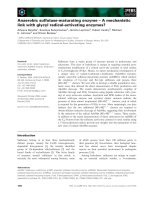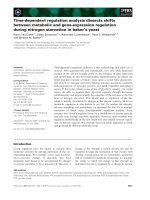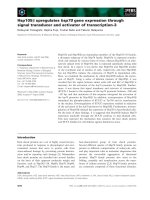Báo cáo khoa học: "Old colchicine-induced polyploid materials of Betula pendula Roth and Betula pubescens Ehrh." docx
Bạn đang xem bản rút gọn của tài liệu. Xem và tải ngay bản đầy đủ của tài liệu tại đây (151.56 KB, 3 trang )
Old
colchicine-induced
polyploid
materials
of
Betula
pendula
Roth
and
Betula
pubescens
Ehrh.
K.
Pieninkeroinen
T.
Valanne
Department
of
Biology
University
of
Turku,
SF-20500
Turku,
Finland
Introduction
The
members
of
the
genus
Betula
form
a
particularly
significant
group
of
broad-
leaved
trees
in
Eurasia
and
North
America.
Certain
birch
species,
e.g.,
B.
pendula,
B.
pubescens
and
B.
papyrifera,
are
valuable
sources
of
wood
and
great
importance
is
attached
to
breeding
work
aimed
at
their
economic
improvement.
Polyploidy
induced
by
colchicine
treat-
ment
in
B.
pendula
and
B.
pubescens
has
been
ieported
by
Johnsson
and
Eklundh
(1940),
Schrbck
(1951)
and
Valanne
(1972).
The
rate
of
growth
of
induced
Betula
polyploids
has
been
observed
to
be
inferior
to
that
of
the
diploid
parental
trees
(Johnsson,
1956;
Eifler,
1955;
1967).
It
has
also
been
reported
that
triploid
B.
pendula
trees
obtained
from
cross-pollina-
tion
of
colchicine
tetraploid
and
diploid
trees
did
not
grow
faster
than
the
diploid
control
plants
(Johnsson,
1956).
The
aim
of
this
study
was
to
reveal
possible
breed-
ing
and
evolutionary
trends
in
B.
pendula
and
B. pubescens.
Materials
and
Methods
The
material
was
part
of
about
2000
individually
numbered
ca
25
yr
old
B.
pendula
and
B.
pubescens
trees,
which
originated
from
exten-
sive
colchicine
experiments
with
different
birch
species
carried
out
in
Finland
(Valanne,
1972).
The
birches
from
the
experiments
are
located
on
the
island
of
Seili
(60°12’
N,
21 °55’
E),
at
the
Experimental
Station
of
the
Finnish
Forest
Research
Institute,
Punkaharju
(61 °43’
N,
29°25’
E),
at
Päilahti
by
Orivesi
(61°37’
N,
24°29’
E)
and
in
the
Botanical
Garden
of
the
University
of
Turku,
Ruissalo
(60°26’
N,
22°10’
E).
From
the
materials
of
Punkaharju,
Orivesi
and
Turku,
50
8. ,nendula
and
50
B.
pubescens
trees
were
taken
for
this
study.
The
chromosome
counts
were
carried
out
according
to
the
method
of
H6mm6
and
Sarki-
lahti
(1986),
using
young
leaves.
Arnott’s
(1959)
method
of
clearing
leaves
was
used
to
study
stomata.
For
the
measurement
of
wood
fibres
and
vessels,
wood
tissue
was
macerated
ac-
cording
to
the
method
for
broad-leaved
trees.
Results
The
retarding
effect
of
colchicine
on
the
height
growth
of
birches
is
strong.
In
the
colchicine-induced
polyploids,
both
the
height
and
the
diameter
(dbh)
were
signifi-
cantly
smaller
than
in
the
colchicine-treat-
ed
chromosom;!lly
normal
trees
(Table
I).
Some
diploid
B.
pendula
trees
reached
a
height
of
nearly
20
m,
while
the
highest
polyploids
were
under
14
m.
The
colchi-
cine
treatment
caused
branching.
No
sta-
tistically
significant
difference
was
found
in
branch
numbers
between
the
groups.
The
petioles
of
polyploid
B.
pendula
trees
were
thicker
than
those
of
diploid
ones,
containing
more
parenchymatous
and
vascular
tissue.
In
the
tetraploids,
the
cell
size
of
the
parenchymatous
tissue
was
greater
in
relation
to
other
cell
types
than
in
the
diploid
trees.
In
the
polyploid
trees,
the
sclerenchymatous
tissue
around
the
vascular
bundle
seemed
to
be
more
abundant
and
its
cells
often
had
thinner
walls
than
in
the
diploids.
The
guard
cells
of
the
stomata
were
significantly
longer
in
the
induced
poly-
ploids
than
in
the
colchicine-treated
chro-
mosomally
normal
trees
(Table
II).
The
lengths
of
the
guard
cells
of
the
normal
trees
were
on
an
average
70%
of
those
of
the
induced
polyploids.
In
the
colchicine
polyploids,
the
wood
fibres
and
vessels
were
statistically
signifi-
cantly
longer
and
the
vessels
wider
than
in
the
chromosomally
normal
trees
(Table
II).
The
mean
lengths
of
the
fibres
and
ves-
sels
of
polyploid
B.
pendula
were
several
tens
of
micrometres
smaller
than
those
of
polyploid
B.
pubescens.
In
some
B.
pubescens
trees
with
the
longest
wood
fibres,
the
mean
length
exceeded
1
mm.
The
shortest
wood
fibres
were
recorded
in
some
diploid B. pendula
trees,
the
mean
value
being
under
0.6
mm.
Discussion
and
Conclusion
Retardation
of
the
height
groswth
is
a
typ-
ical
effect
of
colchicine
in
the
Betula
spe-
cies
studied
(Table
I).
This
has
already
been
seen
in
the
initial
stages
of
saplings
(Johnsson
and
Eklundh,
1940;
Valanne,
1972).
On
the
other
hand,
the
cell
size
of
colchicine
polyploids
is
greater
(Table
II),
and
the
leaves
and
leaf
organs
are
greater
than
at
the
diploid
level.
The
chromosome
number
of
a
consider-
able
part
(33
trees)
of
the
B.
pubescens
material
is
heptaploid
with
7x
=
98,
and
only
a
small
number
of
the
trees
have
the
expected
8x = 112
(6
trees).
The
large
proportion
of
heptaploid
trees
suggests
that
the
chromosome
set
of B.
pubescens
consists
of
42
+
14
chromosomes
(3x
+ x),
and
that
in
the
colchicine
treatments
42
chromosomes
have
been
duplicated,
while
14
chromosomes
are
unchanged.
In
our
experiments
with
birches
of
the
sub-
section
Nanae
(B.
glandulosa
and
B.
nana,
both
2n
= 28,
x
= 14),
no
colchicine
polyploids
have
been
obtained.
In
the
liter-
ature,
it
has
been
suggested
that
the
B.
pubescens
genome
contains
a
genome
of
the
subsection
Nanae
(e.g.,
Walters,
1968).
The
abundance
of
trees
with
7x
=
98
occurring
in
our
B.
pubescens
material
supports
this
suggestion.
References
Arnott
J.
(1959)
Leaf
clearings.
Turtox
News
37,
192-194
Eifler
I. (1955)
Künstliche
polyploidie-erzeugung
bei
Picea
abies
und
Betula
verrucosa.
Z.
Forst-
gen.
Forstpflanzenzucht.
4, 162-166
Eifler
I.
(1967)
Anwendungsm6glichkeiten
der
polyploidie-zYchtung
in
der
forstwirtschaft.
Arch.
Forstwes.
1 Et,
515-528
Hbmmb
L.
&
Särfcilahti
E.
(1986)
A
method
of
counting
chromosomes
of
hardwood
trees
using
root
tips
and
young
leaves.
Can.
J.
For.
Res.
16, 401-403
Johnsson
H.
(’1956)
Auto-
and
allotriploid
Betula
families,
derived
from
colchicine
treat-
ment.
Z.
Forstgen.
Forstpflanzenzijcht.
5,
65-70
Johnsson
H.
&
Ek.lundh
C.
(1940)
Colchicinbe-
handling
som
metod
vid
vdxtf6redling
av
16v-
trad.
Sven.
Papperstidn.
43,
355-360,
373-377
Schr6ck
O.
(1951)
Stimulierende
wirkung
des
colchicins
bei
der
keimung
und
wachstum
der
sdmlinge.
Ziechter,
21,
142-149
Valanne
T.
(1972)
Colchicine
effects
and
colchi-
cine-induced
polyploidy
in
Betula.
Ann.
Acad.
Sci.
Fenn.
Ser.
A4
Biol.
191,
1-28
Walters
S.M.
(1968)
Betula
in
Britain.
Proc.
Bot.
Soc.
Br.
lsl.
7, 179-180









